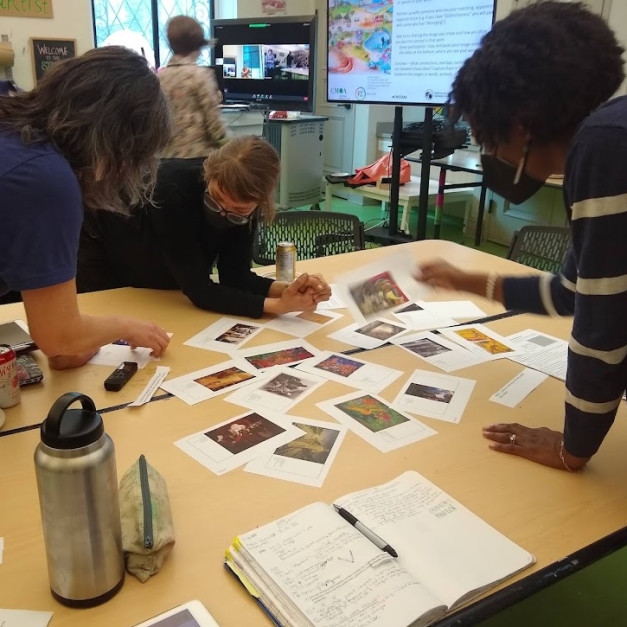Cultivating Creative & Civic Capacities

We all belong to communities that are facing complex challenges and are full of opportunities for more fairness, beauty, and sustainability. This is true from the classroom to the global stage. Cultivating Creative & Civic Capacities offers an empirically-based framework and resources for educators and learners to engage this complexity with imagination, critical thinking, care, and agency.
What is C4?
The Cultivating Creative & Civic Capacities (C4) framework was created by researchers at Project Zero and the Columbus Museum of Art, working with a group of K-12 public school teachers. C4 is grounded in the explorations of these educators harnessing the potential of Thinking Like an Artist and of thinking with art across disciplines.
C4 supports teachers and students to navigate and harness our fundamental Interconnectedness as unique citizens of a shared world, and to
Slow down and reframe to Investigate complexity,
Imagine collectively how the world could be otherwise,
and transform our ideas into meaningful Influence,
Toward more fairness and sustainability in our worlds.
For more information, or to get involved in teacher workshops and the C4 community, email jennifer.lehe@cmaohio.org
C4 was made possible by the Martha Holden Jennings Foundation with additional support from Battelle.
Follow these links below for specific C4 resources:
C4 at-a-glance – The premise, rationale, and overview information about the project, along with key points and potential challenges for each of the C4 lenses (Interconnectedness, Investigation, Imagination, Influence). Good for: Gaining a introductory understanding of C4 and what makes it unique and powerful; revisiting for clarification as you explore C4 in your practice.
Concept Papers – Explore the four core lenses of C4 – ideas for viewing situations in creative and civic ways. Good for: Teacher reflection and group discussion; a conceptual grounding and “why” for the other resources.
Ideas for Practice – Concise ideas for tapping into each C4 concept in your practice, developed with the teacher-researchers of C4. Ideas range from simple phrases that target C4 thinking to broader inspiration for year-long explorations. Good for: Finding a starting point that integrates well into your context and teaching style.
Tools – Activities that support a specific C4 concept lens: Investigation, Imagination, Influence, and Interconnectedness. Good for: Promoting creative engagement with civic matters; creating routines to set a classroom culture of exploring the C4 terrain.
Creativity Challenges – Playful prompts to support creative and civic habits. Includes tips and variations to tailor to your contexts. Good for: Encouraging divergent thinking; loosening students up to approach civic topics with imagination and courage; promoting collaboration and culture-building.
C4 Thinking with Art Kit – A thinking routine and follow-up questions, tips sheet, and sample art works from the CMA collection to promote observation-based exploration and other types of C4-supportive thinking. Good for: Getting started with using art to practice habits of Investigation, Imagination, Influence, and Interconnectedness; launching conversations that embrace ambiguity.
Cubes for C4 Practice – Cut, fold, and roll these cubes to thinking in C4 ways. This pdf includes a teacher planning cube and two cubes for student use: one for unearthing C4 connections to content and one for adopting different points of view to support Investigation.
We are grateful for the courageous investigations and imaginations of the C4 teachers:
Marc Alter, Maggie Boggess, Lindsey Danhoff, Lori Ehrensberger, Becky Grabosky, Eric Gregg, Dione Greenberg, Molly Hinkle, Rachelle Howland, Laura Koontz, Karmyn Metzger, Sarah Pence, Emily Reiser, Sarah Rough, Christine Scarborough, Pam Sexton, Meredith Stone, Matt Szozda, and Andrea Vescelius.
C4 project team:
Project Zero: Flossie Chua, Mara Krechevsky, David Perkins, Julia Wareham
Columbus Museum of Art: Jason Blair, Caitlin Lynch, Jennifer Lehe, Britanie Risner, Cindy Meyers Foley
Click here to be inspired by the culminating reflections of our C4 teacher researchers.
Why C4?
Constructive engagement with the challenges of our times is difficult. How can schools be places that nurture students’ imagination and critical thinking to act with care and an embrace of our fundamental interconnectedness with other another and the world?
Creativity can empower us to imagine, explore complexity, and bring our ideas into the world. Civic-mindedness can help us understand ourselves and one another as both independent and interdependent. It can enable us to negotiate the tensions, and tap the potential, of living together in shared societies. When we nurture creativity and civic-mindedness in tandem, we can support students in being imaginative, thoughtful, collaborative agents in building better worlds.
Why the Columbus Museum of Art?
Artists question the world around them and create ideas that are both original and influenced by their cultural and social contexts. Powerful art can inspire viewers to consider the world – and their relationships to different people, places, and times – in new, more complex ways; imagine possibilities; and think expansively about how to inspire and impact others.
